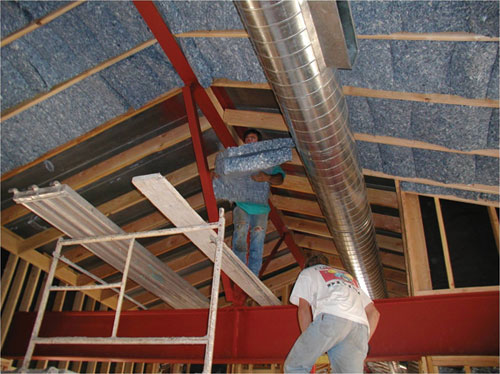Specifying Building Insulation for Sustainable Design, Energy Savings, and Acoustic Control
Specifying Green or Sustainable Building Insulation Materials
Beyond the commonly thought of energy transfer and acoustical design properties, all insulation materials have other notable properties that can contribute to or detract from the overall green or sustainable natures of a particular building. Once potential insulating materials are identified for use, they need to be assessed using the following checklist for green characteristics:
- Optimizing energy performance.Many green and sustainable designs start with this primary goal and strive for high performance through strong building envelope designs. Do your potential insulation materials address all methods of heat transfer appropriately? If so, are the tested or rated conditions similar enough to the design conditions such that accurate estimates of energy performance can be determined? These points are discussed in greater detail in the next section.
- Sound control in interior environments. Increasingly, green building designs are addressing this part of interior environments, particularly in school designs. Does the insulation material under consideration achieve the desired NRC and STC ratings when used in the dividing assemblies as designed?
- Selecting materials with recycled content. Insulation does not need to be manufactured from virgin materials. In fact
some excellent products boast significant recycled content for
the primary material as well as the added materials that form binders, treatments, etc. Does the insulation have significant percentages of both pre-consumer (manufacturing) and post-consumer content?Â

Insulation can be manufactured from recycled materials such as newspapers for cellulose insulation or denim fabric for cotton batt insulation.
Photos courtesy Bonded Logic Inc.
- Reducing construction waste. Insulation that is easy to work with and can be readily cut and fit into the building should produce less waste. Further, if there is waste, can it be recycled instead of discarded?
- Selecting regional materials. This item is obviously location dependent, but can the insulation contribute to regional material content in the building?
- Reducing embedded energy in materials. Many building product manufacturers that are serious about their own green processes will assess and identify how their product compares to others in terms of the energy used or the environmental impact of the manufacturing and delivery process. Does the insulation demonstrate favorable results in this area?
- Selecting rapidly renewable materials. Insulation can be made from a variety of raw materials, some of which are made from rapidly renewable sources like cellulose or cotton fiber, while others are from non-renewable sources like petroleum based foam plastic. Does the insulation come from a rapidly renewable material source?
- Indoor air quality contributions. Some insulation materials are better than others at avoiding indoor air quality problems. Since the material is used around the entire envelope, selection based on this criterion can make a considerable difference. Can the manufacturer show that the material contains no harmful irritants or chemicals that can pose concerns about respiratory health including no volatile organic compounds (VOC)?

Insulation has greater resistance to conductive heat losses compared to other building materials.
Photos courtesy Bonded Logic Inc.
- Providing thermal comfort. A fundamental expectation from an insulated space is that it will provide the appropriate level of thermal comfort to occupants by controlling temperature swings and eliminating drafts in some cases. Does the insulation application help insure thermal comfort?
- Innovation.Some insulation products are prone to being used innovatively and can elevate the green building design beyond the typical. Does the insulation under consideration allow such innovation to improve performance?









